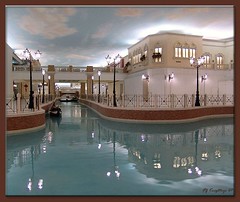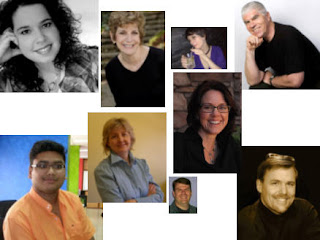
This week's guest for
Flooring The Consumer's Social Media Series: Bridging New & Old is
Kristin Gorski.
Kristin Gorski brings a different perspective to this series: that of a journalist. She's insightful, probing, knowledgeable and open to possibilities. Consider her article for
The Age of Conversation 2 - Why Don't They Get It? Titled "
Crossroads: When Micro Storytelling Meets Social Media," it ends with an interesting yet social media relevant challenge: "
to learn how to slow down, thoroughly survey the social media scene, decide what stories we want to tell, and then utilize this powerful arena to maximize their reach..."Perhaps you've encountered Kristin via her blog,
"Write now is good." or
The Huffington Post where she
has written about technology, new media and the U.S. presidential race for
"The Huffington Post's Off The Bus" series. You'll also find her intensely involved with media literacy site
NewsTrust -- a non-profit, non-partisan site committed to helping citizens make informed decisions about democracy -- as
editor, host and reviewer. [She just ended a
News Hunt about
Top Stories on Education.]
C.B.: Kristin, how/why did you get involved in social media?
Kristin: I started blogging almost three years ago after hearing constant talk about it. I had worked in media and magazines for over a decade, and for part of this time, I designed and managed Web sites and technology projects. Becoming a blogger was a natural next step for me.
Also, I wanted to have a regular outlet for my writing, and I knew the pressure of having an audience and self-imposed deadlines would keep my writing skills sharp by encouraging me to write more.
C.B.: What do you like most about social media?Kristin: Social media constantly reinforces the importance and power of conversation and communication. It has made the world both wider and more personal to me; I've met people from all over the world through outlets like blogging and Twitter, and they've become part of my digital community online–something I didn't have three years ago. My definition of community has expanded, and the connections I've made have spurred greater creativity in my own projects and have allowed me to be part of online writing opportunities, as well. Social media has made it possible for more people to express themselves easily and to be heard. When we talk with each other online, we understand each other better and learn more about the world around us; social media, in its ideal form, supports this. While bloggers may not always agree with each other, the level of debate over time has become more consistent and respectful. With regular practice, bloggers have become used to reading and assimilating differing viewpoints and responding in constructive ways.
C.B. : What do you like least about social media?
Kristin: I like most aspects of social media, but occasionally, an entity will use it in anti-social ways. One example is
Twitter spam, which happens when a Twitterer sends out 140-character advertisements. It turns into a monologue, as the offending Twitterer has nothing substantial to say. Nobody will put up with being on the receiving end of an unwanted one-way conversation for long. I don't like telemarketers during dinner; why would I like tweet spam anytime? (Luckily, tweet spam is easy to ignore – just don't follow the offenders!)
Companies which push the user-privacy envelope use social media in negative ways, and ultimately, hurt their own bottom line.
Facebook's Beacon experiment, and any future derivative of similar tracking and targeting, will not work because it betrays users' trust. Users are real people, not just avatars and accounts online, and
are protective of their online lives. Social media companies have to figure out revenue models which will not haphazardly play with their users' most treasured personal details.
Looking to the future, social network players must carefully frame their interaction with users keeping this in mind: extinction is just around the corner, as another Facebook could spring up. Internet trends can shift rapidly and often, so popularity dips for Facebook, Twitter, et al are just a matter of time. Remember when MySpace was viewed as THE social media deity,
gracing business magazine covers and being constantly talked about? Its
demographic and marketshare have changed over the years, and Facebook is rules as "most buzz worthy" in mainstream media these days.Recently, MySpace users participated in a coordinated
“Delete Your MySpace Account” day. I don't have statistics on how many users actually delete their accounts during these groundswells, and I sense the numbers are quite small, but the sentiment behind them speaks clearly and to something we all sense: these social networking sites are not perfect. What is wrong with social networking sites is both completely obvious and extremely subtle, and differs widely among users.I remember when
Friendster was "it", and now it's definitely not (though it still is "it" to some users, and there's a lesson in that...).
Pownce and
Jaiku exist as partial ghosts in the Internet machine, as Twitter lives large. So current champions Facebook and Twitter have to continually ask themselves, “Am I meaningful to my users? Do I offer them value? My users give me a lot of their time and precious bits of their lives, so what am I giving them in return?” Without users, these sites will simply not exist. Will social networks ever go beyond trend and last "forever" (e.g., top of the heap for roughly 5-10 years)? Only if they are beneficent and extremely useful.
It may be hard to imagine completely new social media outlets on the horizon, but two years ago, did any of us think we'd be so actively using a service like Twitter? Twitter continues to morph in its usefulness, also, as
third-parties create applications based on Twitter's basic tweet structure. Innovators are out there, programming and scheming under heavy caffeination late into the night, dreaming of the Interwebs' next big thing, determined to make it theirs. (In the end, this is good for the users, as this offers more choices of potentially higher quality; as for social media companies involved, only the most relevant will survive.)
C.B.: What 5 suggestions do you have for companies to implement so they can more effectively bridge old media with new media and connect with end users?Kristin:
1. Make sure you want to talk with the consumer in the first place. Just having a Facebook group or Twitter account is not enough. Consistent engagement IS the bridge between old and new media. Customers, both old and new, need time to take in new messages from a trusted (or new) source. If the commitment is not there to engage fully and clearly in some form of social media, then companies should wait until they're ready.
2. Know your story. If a company is not clear on its message and goals, customers pick up on this instinctively. They don't have time to stick around and figure it out: companies have to make their stories clear and compelling for people from the get-go.
3. Have a plan. Lack of organization and an absence of a timetable kill many projects before they even get off the ground. How often should the company tweet? Which employee will take on this responsibility, and what content will be tweeted? Are there resources for YouTube content, and who will take care of a company's YouTube "channel"? Writing company blog posts, answering reader comments, learning about related blog communities, building authentic connections–all this takes time.
4. Keep up the conversation and keep up your end of the bargain. Successful social media connections are a commitment. I always think of Seth Godin's belief that
there is no such thing as an overnight sensation: success is often built over many years of wins and losses, of re-evaluations and re-tooling, and not giving up. This goes for forging new connections through social media, too.
5. Always look for new connections. Be flexible in bridging these connections. Listen to the customers and adapt. If customers aren't responding, think of a new conversation starter, as customer input can guide you. Don't take this customer interaction for granted–not just in a poor economy, but at any time. (Strong bonds with customers forged in stable market conditions probably will help companies better survive a poor economy...)
C.B.: Kristin, any other thoughts to share about the effectiveness of social media in forging stronger relations with customers?
Kristin: When any customer wants to talk with your company, it's a gift and should be appreciated.
WOM marketing is still stronger than anyone realizes, and those corporations unaware of the power combo of [WOM + Blogs/Twitter/Facebook/Email + mainstream media] sometimes learn of it the hard way: an unhappy and vocal group online publicly discusses some company's shortfall and then a news outlet reports negative information about the company as actual news that the entire world should hear about (even though it may have no relevance to our lives). In the Blogosphere or Twitterville or Facebooklandia, there IS such a thing as bad PR.
Tweets are short, but a resulting bad-PR migraine might be eternal (or perhaps last for just a very long week).
Take heart: companies shouldn't be worried about vigilante mobs of social media rumor mongers running rampant all over their carefully created brands, but they should keep one wide-open ear to the rumbling social media ground. That is prudent advice in a world where information, business and reputations play out so much online, and will do so increasingly.
One last point: social media is simply a set of tools. As such, these tools should help people do real things in the brick-and-mortar world. The social media world is not just a virtual world, it is an extension of our flesh-and-blood lives. When we forget this, social media loses relevancy; when social media complements our work, communities, and friendships, we become more powerful and effective. Companies that use social media in just the right way could see more connection and relevance to their users' lives, too.
Thank you, Kristin!Questions? Comments? Reactions?
What about social media platform extinction and the next iteration? What might it look like? What do you think is missing from the current ones?
I love Kristin's characterization of the social media world: "
it's an extension of our flesh-and-blood lives" making it critical that we figure out how best to bridge the two for relevance. How do you see that best happening in your world?
In true journalist fashion, Kristin leaves us with a summary of her sources.
ARTICLES/POSTS SOURCED:
--- "
Facebook's Beacon More Intrusive Than Previously Thought" -- from PCWorld by Juan Carlos Perez, November 30, 2007
-- "
Facebook Strategy? Bloggers, Agencies Beware!" -- from Servant of Chaos by Gavin Heaton, February 17, 2009
--- "
January 30th is International Delete Your MySpace Account Day" -- from Mashable by Mark 'Rizzn' Hopkins, January 21, 2008
--- "
Making Progress on Spam" -- from Twitter's Blog by Evan Williams, August 7, 2008
--- "
Misjudgment or Transparency? How a Single Tweet Caused A Stir With A Client" -- from Web Strategy by Jeremiah Owyang, January 24, 2009
--- "
Overnight success?" -- from Seth's Blog by Seth Godin, May 22, 2006
--- "
The age of Facebook vs. MySpace" -- from TechnoMarketer by Matt Dickman, January 5, 2009
--- "
The MySpace Generation" -- from Business Week (cover story), December 12, 2005
--- "
Twitter Fast Growing Beyond Its Messaging Roots" -- from WIRED by Michael Calore, February 10, 2009
--- "
Word of Mouth" -- Wikipedia entry
Technorati Tags:
Kristin Gorski Write Now Is Good #AOC2 social media series bridging new & old marketing social media Del.icio.us Tags:
Kristin Gorski Write Now Is Good #AOC2 social media series bridging new & old marketing social media
 Time for The Carpetology Blog Roundup for February 2009.
Time for The Carpetology Blog Roundup for February 2009.







